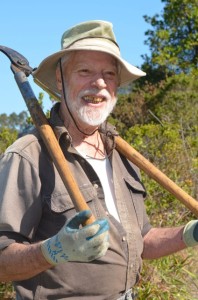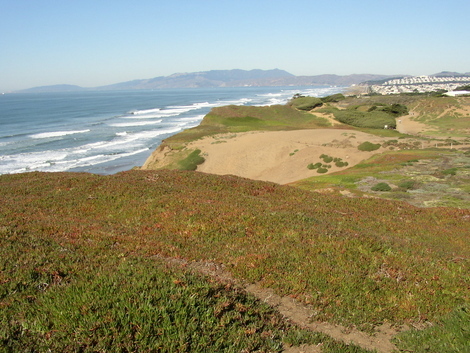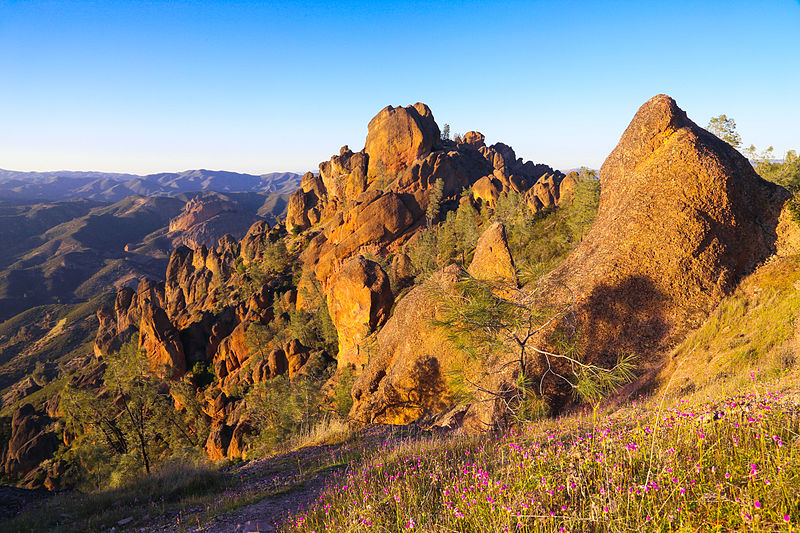
Anyone interested in Bay Area nature and ecology has likely come across Jake Sigg’s Nature News, an indispensable and idiosyncratic email newsletter that goes out to 2,400 subscribers every week.
Nature News—a volunteer project Jake does on his own—is much more than a listing of local hikes, classes, campaigns, and restoration events. At any given time, readers may open it to find a nature poem by Mary Oliver; reflections on the staged 1938 Martian landing in Grovers Mill, New Jersey; spirited discussions of environmental issues; excerpts from The Economist (Eds: Jake’s favorite magazine aside from Bay Nature); and bursts of deeply felt environmental outrage—from Jake or from others. The longtime Golden Gate Parks gardener and native plant advocate (Jake is a former president of the California Native Plant Society’s Yerba Buena chapter and a tireless CNPS volunteer) lives his passion of saving the planet out loud, using his own irrepressible voice.
BN: Are you originally from the Bay Area?
Sigg: No, I was raised on a ranch in Montana. I joined the Navy at the end of WWII, in 1945. I took my boot training in San Diego, and in ’46 they sent me to Treasure Island. That was when I fell in love with San Francisco. I was discharged in ’46 and I had to move back to Montana to take advantage of the GI Bill to help pay for my college education. I graduated from the University of Montana in 1950 with a degree in History and Political Science. During the summers I would work in Glacier National Park, clearing fire trails. Those were the happiest days of my life. I wanted to be a park or a forest ranger, but the city life won out. I moved back to San Francisco in 1950.
BN: What was your “day job” back then?
Sigg: When I first got here, I had no work experience, except for at Glacier. So I took whatever temporary jobs I could find, including working for the Bank of America for a dollar an hour. Bank of America had to personally sign all stock certificates in ink, so they deputized me and another person with a very short name as Vice Presidents of Bank of America so we could sign them all as quickly as possible. Eventually, they offered me a job as a teller and I did that for a couple of years, but I didn’t like that very much. I had a series of jobs like that, but I knew I just couldn’t live my life that way.
BN: And how did you transition into the world of native plants?
Sigg: On one occasion, my mother came to town to visit me. She liked to walk in Golden Gate Park. We walked up a certain hill, and before us in full bloom was Rhododendron Dell. I instantaneously decided that I was going to be a gardener.
I became apprenticed to a landscape designer named Duncan Munro, but all along my goal was to work in Golden Gate Park. I filed an application with the Civil Service Commission, and in 1959, I started working at the park. In 1983 I became supervisor of gardeners in Strybing Arboretum. Fifteen years later there was a “budget crisis” and I was transferred to the distant southeast corner of the city. I found pieces of the original landscape, wildflower fields, needing urgent attention. Overnight I decided this was what was important; horticulture is superficial compared to complex natural systems, so I decided to retire and devote my life to ecological restoration.
With the arboretum absorbing all my time and energy, I was able to assume the presidency of the local chapter of the California Native Plant Society (CNPS). Ecological restoration became the chapter’s focus and has been since.
Greg Gaar and I had been out there for several years trying to save the native plants and animals that existed only on these pieces of the original landscape. Greg is a photographer and historian, and has a huge collection of early San Francisco photographs. He and I had a dog and pony show we took around to neighborhoods. He crafted his show to the particular neighborhood, and they loved his shows. We talked about the development of the city and the corresponding diminution of our biological heritage, and tried with partial success in getting people interested in taking care of these lands in their own backyard.
BN: How did Nature News begin?
Sigg: Nature News started in 2002 by accident, when I started an email group to inform people about upcoming public meetings concerning San Francisco’s threatened Natural Areas Program.
In 1997 the National Park Service began to crack down on dogs running off-leash at Fort Funston, but evidently they did so too suddenly, which set off a backlash by the off-leash dog activists, who became an organized force. They attacked not only the National Park Service but the Recreation and Park Department’s infant Natural Areas Program (NAP) as well, telling community groups that the NAP was going to fence off their neighborhood park and people couldn’t use it anymore–and people actually believed this. By the time we found out about it the damage had been done, and we are still suffering from it.

That started a two-and-a-half-year period of meetings at The Park and Recreation Commission and the Board of Supervisors. So I started an email group to inform people I knew who were interested in saving our biological heritage. Just listing meetings got to be boring, and I padded emails with quotations, items that had to do with the natural world, then adding an expanded view of nature: science, astronomy, human nature, poetry. These things unobtrusively became the driver, and the listing of events and meetings became the excuse.
Some people took me to task for subjects that had a hard time fitting under the rubric ‘nature’. I didn’t care; history, nutrition, biography, items that interested me got in there, and I stopped trying to invent reasons for including them. The newsletter is an outlet for me. I hope some people read them, but I write them even if they don’t. Many value its eclectic nature, so I feel exonerated.
There are now so many events, and people/organizations looking for ways to disseminate their activities beat a path to my door. The newsletter has become a burden, but I’m unable to let it go. There are now three per week, which is too many for people to read. I won’t give up the stuff that is fun for me, and events have their own momentum. What to do?
BN: What impact does Nature News have?
Sigg: It’s hard to say. I only know what people tell me. Some people say that it inspires them, which I find difficult to believe, because my outlook on the world is pretty dark. I try to avoid publishing “crisis alerts” because it burns people out. There’s a lot of anxiety and depression in the world and I don’t want to make it worse. But there’s a side of me that people pick up on, not my brain but my gut, which seems still hopeful.
BN: What is the greatest challenge you face?
Sigg: The sheer volume of material. I really need staff, but it comes from my brain and personality and reflects my values and my life. I have articles, even books, in my brain that will never materialize for lack of time.
BN: What is your favorite outdoor destination in the Bay Area?
Sigg: I don’t have destinations anymore. I’ve hiked the world and I don’t want to do that anymore. All I want to do is stay home and work to save these areas. But I do love Pinnacles National Park–that desert canyon country again. There’s both grandeur there and fragile beauty and diversity. You see all these magnificent stone formations. I love rock. And the colors, pink, and salmon . . . there’s a lot more to it than that, but I can’t put it into words.

BN: Which area is your priority to save?
Sigg: The 31 natural areas within the City & County of San Francisco, or the parks in northern San Mateo County: San Bruno Mountain, San Pedro Valley County Park, Pedro Point Headlands, Pacifica State Beach, the San Francisco watershed lands. They all desperately need help from people who care. Fortunately, there are rays of hope. Recently, events have improved the outlook for some of these San Mateo parks. And as long as there’s a ray of hope I hang in there.
>> To sign up for Jake’s Nature News email newsletter, visit his blog
(Click the link at the top of the page, where it says “I welcome feedback; just click this link to reach me.”)
>> Learn what originally inspired Jake’s passion for the environment.




